Asian Longhorned tick
Haemaphysalis longicornis
Identification
The Asian longhorned tick is light brown to reddish-yellow in color.1,2 The adult female grows to the size of a pea when full of blood. In other stages, the tick is very small — about the size of a sesame seed or even smaller. Both nymphs and adults have four pairs of legs.1, 2
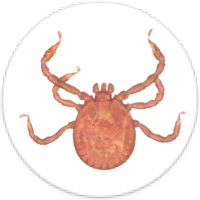
Larva
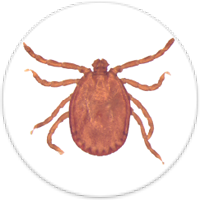
Nymph
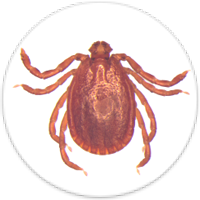
Female
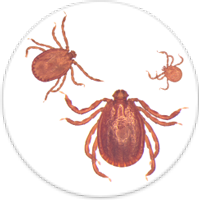
Family
Approximate Distribution
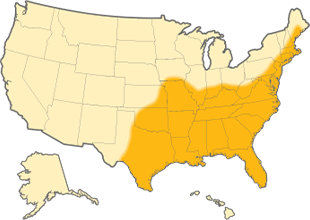
The American dog tick is widely distributed in the United States, from Montana to south Texas and eastward to the Atlantic coast. It’s also been reported along the Pacific coast, in the eastern United States, and in central states including Iowa and Minnesota.13, 14
Hosts

As the name suggests, this is most commonly found on dogs in its adult stage. Adults will also readily attach to larger mammals like cattle, horses, and humans. At the larvae and nymph stage, it targets smaller mammals.13
Habitat

This tick is commonly found along forest edges and in areas with little or no tree cover, like grassy fields and scrubland. It can also be found along walkways, sidewalks, and trails.15
Diseases associated with Haemaphysalis longicornis
While there have been no reports of disease transmission in companion animals in the United States, the longhorned tick is known to transmit the agents of certain livestock and human diseases in other countries. Diseases include:
Anaplasmosis is caused by the bacteria Anaplasma phagocytophilum. It primarily affects dogs (infection in cats is rare). Dog with anaplasmosis may never show signs of illness or require treatment. Those that do commonly respond to antibiotics.23
Clinical Signs
In dogs:23
● Decreased energy
● Decreased appetite
● Dehydration
● Some dogs may show no signs
Diagnosis and testing
To diagnose anaplasmosis, your veterinarian will usually use a blood test to detect antibodies. In some cases, a positive antibody test might indicate previous exposure, rather than an active infection needing treatment.23
Treatment
The antibiotic doxycycline is commonly used to treat anaplasmosis. Dogs often start to feel better in one or two days after starting antibiotics, but treatment should continue for at least two weeks. If a dog tests positive for the antibody but shows no signs of the disease, antibiotic treatment is not required.23
References:
23. Anaplasmosis. Cornell Richard P. Riney Canine Health Center. https://www.vet.cornell.edu/departments/riney-canine-health-center/canine-health-information/anaplasmosis
Babesiosis is a potentially fatal disease that can affect a wide range of animals, including pets and humans. In pets, it can be caused by the organisms Babesia canis and Babesia gibsoni.24
Clinical Signs
In both dogs and cats:25
● Decreased energy
● Weakness
● Loss of appetite
● Jaundice
● Weight loss
If the disease progresses, long-term signs include bleeding and bruising caused by low levels of platelets in the blood.
Diagnosis and testing
Veterinarians diagnose babesiosis using several methods, including a physical examination, a detailed medical history, and microscopic evaluation of blood. They may also use advanced techniques to test for the genetic material of the Babesia organism or to identify antibodies produced in response to Babesia to help determine the infection’s presence and severity.25
Treatment
The treatment of babesia is often dependent on what species of Babesia is present in your dog. Treatments may include antibiotics (azithromycin or clindamycin) and/or anti-fungal/anti-parasitic medications like atovaquone or Imizol® (imidocarb). Dogs may also get supportive care, such as intravenous fluids.26
References:
24. Blood Parasites of Dogs. Merck Vet Manual. https://www.merckvetmanual.com/dog-owners/blood-disorders-of-dogs/blood-parasites-of-dogs
25. Babesiosis in Animals. Merck Vet Manual. https://www.merckvetmanual.com/circulatory-system/blood-parasites/babesiosis-in-animals
26. Babesiosis in Dogs. VCA Animal Hospitals. https://vcahospitals.com/know-your-pet/babesiosis-in-dogs
Ehrlichiosis is a serious disease caused by the Ehrlichia bacteria. It affects both dogs and cats.33, 34
Clinical Signs
In dogs and cats:33, 34
● Swollen lymph nodes
● Loss of appetite
● Depression
● Muscle stiffness
● Coughing
If the disease progresses, long-term signs include bleeding and bruising caused by low levels of platelets in the blood.
Diagnosis and testing
Diagnosing ehrlichiosis involves a combination of observing clinical signs and conducting blood and laboratory tests, which help confirm the presence of the Ehrlichia organism and assess the severity of the infection.33, 34
Treatment
The primary treatment for ehrlichiosis in both dogs and cats typically involves the use of doxycycline, an antibiotic. It can also include supportive care to address symptoms and keep your pet more comfortable.35
References:
33. Ehrlichiosis and Related Infections in Dogs. Merck Vet Manual. https://www.merckvetmanual.com/dog-owners/disorders-affecting-multiple-body-systems-of-dogs/ehrlichiosis-and-related-infections-in-dogs
34. Ehrlichiosis and Related Infections in Dogs. Merck Vet Manual. https://www.merckvetmanual.com/cat-owners/disorders-affecting-multiple-body-systems-of-cats/ehrlichiosis-and-related-infections-in-cats
35. Ehrlichiosis, Anaplasmosis, and Related Infections in Animals. Merck Vet Manual. https://www.merckvetmanual.com/generalized-conditions/rickettsial-diseases/ehrlichiosis,-anaplasmosis,-and-related-infections-in-animals
Spotted fever group Rickettsiosisis a group of diseases caused by various species of the Rickettsia bacteria. They can affect both cats and dogs, though cats generally show no symptoms and may have been infected by contact with fleas, not ticks.38, 39
Clinical Signs
In dogs:38
● Loss of appetite
● Swollen lymph nodes
● Painful joints
● Coughing
● Vomiting
● Diarrhea
● Swelling of face or extremities
Diagnosis and testing
To diagnose a dog, your veterinarian will likely use a combination of observing the signs and conducting blood and laboratory testing.38
Treatment
Treatment typically involves the use of the antibiotic doxycycline. In addition to medication, your pet may receive supportive care and careful monitoring to help manage symptoms and ensure well-being.38
References:
38. Rocky Mountain Spotted Fever in Dogs. Merck Vet Manual. https://www.merckvetmanual.com/generalized-conditions/rickettsial-diseases/rocky-mountain-spotted-fever-in-dogs
39. Flea-borne Rickettsiosis. Companion Animal Parasite Council. https://capcvet.org/guidelines/flea-borne-rickettsiosis/
References:
1. Longhorned Tick: Information for Livestock and Pet Owners. United States Department of Agriculture. https://www.aphis.usda.gov/publications/animal_health/fs-longhorned-tick.pdf
2. Asian Longhorned Tick. Cornell College of Agriculture and Life Sciences. https://cals.cornell.edu/new-york-state-integrated-pest-management/outreach-education/whats-bugging-you/asian-longhorned-tick
3. National Haemaphysalis longicornis (Asian longhorned tick) Situation Report. United States Department of Agriculture. https://www.aphis.usda.gov/animal_health/animal_diseases/tick/downloads/longhorned-tick-sitrep.pdf

 Austria
Austria Belgium
Belgium Czech Republic
Czech Republic Denmark
Denmark Europe
Europe Finland
Finland France
France Germany
Germany Greece
Greece Hungary
Hungary Ireland
Ireland Israel
Israel Italy
Italy Netherlands
Netherlands Norway
Norway Poland
Poland Portugal
Portugal Romania
Romania Spain
Spain Sweden
Sweden Turkey
Turkey United Kingdom
United Kingdom United States
United States